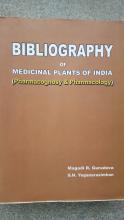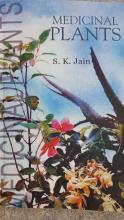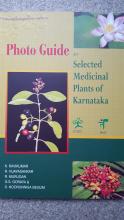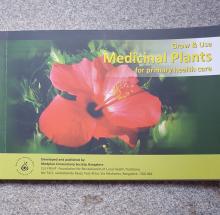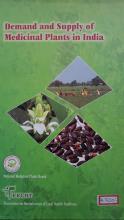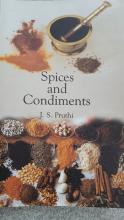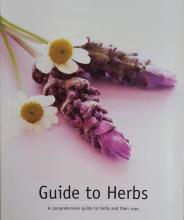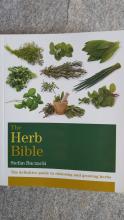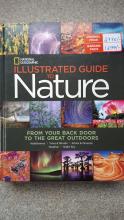Agriculture and Rural Development
Title: Bibliography of Medicinal Plants of India
Authors: Magadi R. Gurudeva & S.N. Yoganarasimhan
Publisher: Divyachandra Prakashana, Papanna Garden, Bangalore
Year: 2009 Pages: 1024 Rs.1,000/-
Medicinal plants research in India has gained prominence during the last three decades. At the same period, the number of journals publishing information on medicinal plants has increased all over the world. As a result, it is becoming increasingly difficult for the research workers to keep track of the work carried out. Important reason for this is the inaccessibility of the journals; Consequently, many research workers are repeating the research carried out earlier.
Keeping this in view, this bibliography attempts to provide updated information till the year 2007 on work carried out in the fields of Pharmacognosy and Pharmacology of Medicinal Plants of India including some exotics/ introduced/ naturalised species.
The Bibliography contains information about 1521 species, distributed over 851 genera. The names of the plants are arranged alphabetically. For each plant, the correct name along with author citation is given in bold letters, followed by important synonyms, if any, in parenthesis. This is followed by author’s name, arranged alphabetically, year, full title of paper as mentioned in journal, name of journal with volume, issue and page numbers.
Title: Botanical And Vernacular Names of South Indian Plants
Author: Dr. Magadi R. Gurudeva
Publisher: Divyachandra Prakashana, Papanna Garden, Bangalore
Year: 2001 Pages: 1,000 Rs.800/-
Survival of human race on earth depends entirely on plants. Naturally, from ancient times, man became curious about the life and uses of plants which led to the study of plants in various ways. In the last five decades, this study has developed into several important fields like bio-diversity, Food and Agriculture, Ecology, Environment and Health, Tissue Culture, Genetic Engineering, Hydroponics, to name a few.
It is inevitable for us to be familiar with the plants surrounding us and the plants which are essential for our survival. However, plants are recognised by us, to begin with, in our own vernacular or folk name. In a country like India, where diversity is vast, several communities live in different parts of the country. The plants surrounding these diverse communities and used by them are recognised in their own language by a vernacular or folk name.
Thus, a plant with one botanical name is known by many vernacular or folk names. The value of recognising a plant with the help of a vernacular or folk name becomes clear when it is botanically identified and its usefulness to society is established.
Title: Medicinal Plants
Author: S. K. Jain
Published by: National Book Trust, India, New Delhi
Pages: 216 Price: Rs.85/-
“Medicinal Plants” by S. K. Jain presents about 100 medicinal plants of India. It includes only authentic information based on pharmacological and other experimental work.
In olden days, many people believed that medicinal plants had miraculous properties like bringing the dead back to life. As times changed, people started weighing everything with reason and several of earlier beliefs seemed unsound. As a result, the use of medicinal herbs declined.
Until 1950, few of our medicinal plants had been subjected to scientific testing and experimentation. Consequently, it was difficult to state with certainty for or against the claims of their efficacy.
Now, this book deals with important medicinal plants of India, narrating their authentic medicinal properties in a lucid manner. The book has become very popular with two revised editions (latest one in 1996) and several reprints. For each plant, botanical name along with names in several Indian languages is given in the book and this has made it very useful.
Title: Photo Guide to Selected Medicinal Plants of Karnataka
Author: K. Ravikumar and others
Publisher: Foundation for Revitalisation of Local Health Traditions (FRLHT), Bengaluru
Year: 2009 Pg: 117 Rs. 200/-
Plants support and sustain all living beings on earth. They convert carbon-dioxide to oxygen that is absolutely necessary for all lives. They play an important role in maintaining ecological balance and keep the atmosphere in balance. Human beings are dependent on plants for all their needs like food, clothing, shelter and medical care.
India has rich and diverse plant resources with about 20,000 species of flowering plants. Out of these, nearly 8,000 plant species have been recorded as medicinal and hence India is considered as “Emporium of Medicinal Plants”. About 70% of our population still depends upon these plants linked to traditional medical practices for their primary health care.
The medicinal uses of these species are recorded in the 4 codified Indian systems of medicine: Ayurveda, Siddha, Unani and Tibetan (Swa-rigpa). They are also reported in the folk traditions of different ethnic communities across the country.
Title: Grow & Use Medicinal Plants for Primary Health Care
Author: Experts of FRLHT and MCS
Publisher: Medplan Conservatory Society (MCS), Bengaluru
Year: 2009 Pg: 88 Rs. 80/-
We depend upon plants for our health care to a large extent. By spending their lifetime, our ancestors have found out and documented the healing properties of various plants growing in the neighbourhood. This cumulative knowledge has been meticulously passed on to generations through oral and codified traditions.
We are fortunate because we are present custodians of this collective wisdom. Different communities of India now know the use of more than 7,500 plant species (out of rich flora of India with about 8,000 botanical entities) to treat various ailments. It is our responsibility to maintain this invaluable knowledge treasure and ensure its transmission to our next generations.
We should accept the fact that the best quality medicinal plants are those derived from a home garden. They have a time-tested potential to provide a ready-at-hand solution to many of the primary ailments or health disorders.
Therefore, this book explaining common health problems and the use of 40 plants in their treatment is a welcome publication from MCS. The guide contains colour photos of 22 plants for easy identification.
Title: Demand and Supply of Medicinal Plants in India
Authors: D.K Ved and G.S. Goraya
Publishers: FRLHT, Bengaluru and Bishen Singh Mahendra Pal Singh, Dehra Dun
Year: 2008 Pg.216 Rs.1,250/-
Medicinal plants are not only a major resource base for the traditional medicine & herbal industry but also provide livelihood and health security to a large segment of Indian population.
Information drawn from the published records on codified Indian Systems of Medicine (Ayurveda, Siddha, Unani, Swarigpa and Homoeopathy) and ethno-medicinal practices in the country reveals that about 6,000 plants species are used in the Indian health care traditions. It is also a matter of record that more than 9,000 registered manufacturing units are engaged in making herbal based formulations the country.
In this scenario it becomes important to know the number of medicinal plant species being consumed by the herbal manufacturing units, the quantum of such consumption and the gaps in the demand and supply of the medicinal plants.
Therefore, a study was sponsored by National Medicinal Plants board (NMPB), through the Foundation for Revitalisation of Local Health Traditions (FRLHT), Bengaluru with the objective of finding answers to issues related to demand and supply of medicinal plants in the country. This boo presents report of the study.
Title: Spices and Condiments
Author: J. S. Pruthi
Published by: National Book Trust, India, New Delhi
Pages: 322 Rs.160/- First Edition: 1976, 5th: 1998 Reprints:4
This popular book covers the nomenclature, description, distribution, composition and uses of 86 spices. The book has also been translated into several Indian languages.
The various uses of spices in foods and beverages as flavourings, in medicine, and in perfumery and cosmetics are described in the book. It also covers the PFA quality standards for spices, as well as lists of other national (Agmark, ISI or BSI) and international (ISO) standards for spices, their products and their methods of test.
In ancient times, spies ranked with precious stones in the inventory of royal possessions and were monopolised by the few. Even today, spices and condiments play an important role in the national economies of several spice producing, importing and exporting countries. There is considerable volume of international trade in spices.
India is considered to be the “Home of Spices”. It is one of the major spice producing and exporting countries of the world. From 1980 to 1996-97, the increase in the foreign exchange earnings, by the export of spices was 1,200%.
Title: Guide to Herbs
Author: Jenny Linford
Publisher: Parragon, 4 -Queen Street, UK
Year: 2012 Pages: 144 (Printed in Art Paper) ISBN 978-1-4454-6989-8
Herbs are very versatile plants. Their wonderful scents, colours and flavours have been used by generations of human beings for thousands of years in cooking and cosmetics and for dyeing fabrics. They have always been known for their healing properties. Even now, scientists are still discovering why some herbs are very potent healers.
This “Guide to Herbs” contains a wealth of information about more than 100 of the world’s most widely used herbs. With the help of superb colour photographs and useful fact-boxes, the reader can learn about the appearance, origins and habitat of each herb. Medicinal, culinary and cosmetic uses (both traditional and contemporary) of the herbs are also presented in the guide.
Botanists use the term “herb” to refer to a plant with a stem that is not woody, yet the term has taken on a larger meaning. An experienced cook would consider herb as a plant used to add flavour in cooking, such as basil. On the other hand, many people may consider herbs to be plants that are extensively used medicinally, such as aloe vera.
Title: The Herb Bible
Author: Stefan Buczacki
Publisher: Octopus Publishing Group Ltd., London
Year: 2015 Pg. 320 Rs.750/-
This attractive book presents information on 130 herbs by horticultural expert Stefan Buczacki. There is at-a-glance information on these herbs with advice on how to grow and their best uses - both culinary and ornamental.
In the first 33 pages, useful information on these aspects is given: Site and Soil suitable for herbs, Design and Styles of Herb Gardens, Plants and Planting, After-care and Propagation, Picking and Preserving herbs, Pest and Diseases Control. At the end, index is given in six pages.
However, this is a gardening book and not a cookbook or herbal medicinal book. It is written from the standpoint of a gardener who wants to grow a range of herbs to use in the kitchen but who also has an interest in those many others with medicinal roles. So, while general kitchen use have been indicated, recipes are not given. Details of the way that the herb plants are prepared for medicinal use are also not given.
Title: Illustrated Guide to Nature
Authors: Catherine Herbert, Bland Crowder and others
Publisher: National Geographic Society, Washington, USA
Year: Pages: 448 Art Paper Rs:1299/-
Studies conducted at the University of Kansas show the benefit of spending more time in nature. Testing the theory that “nature has specific restorative effects on the prefrontal cortex” - the part of the brain responsible for creativity and planning - the researchers gave a standardised problem - solving test to backpackers aged 18 to 60, before and after a four-day sojourn into the wilderness. Campers returning scored 50 percent higher.
Why? “Nature is a place where our mind can rest, relax and let down those threat responses,” says Ruth Ann Atchley, lead investigator. When we spend time in nature, Atchley, proposes, “we have resources left over - to be creative, to be imaginative, to problem-solve - that allow us to be better, happier people who engage in a more productive way with others.”
This richly illustrated volume is an excellent guide to the amazing views and vistas of North America’s natural world. It is designed to invite people, young and old, to step with greater pleasure into the out-of-doors. The purpose of the book is to educate and entertain.

